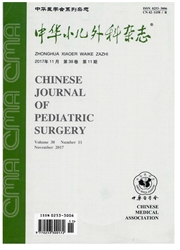

 中文摘要:
中文摘要:
目的检测胆道闭锁(BA)患儿HEX基因的单核苷酸多态性(SNPs),探索HEX基因的单核苷酸多态性与BA发病的相关性。方法Ⅲ型BA的患儿30例,经术中胆道造影确诊,男17例,女13例,年龄1~5个月,其中1~2个月10例,2~3个月12例,大于3个月8例。同期住院的非胆道畸形患儿20例为对照组。提取外周血白细胞的DNA,对HEX基因的全部4个外显子进行PCR扩增,PCR产物直接测序,判定HEX基因单核苷酸多态性的位置和类型及其与BA发生可能存在的相关性。结果30例BA患儿中,共发现3个多态性位点,其中5例患儿存在第1个外显子24G/A多态性位点;3例患儿存在第3个外显子29T/G多态性位点;1例患儿存在第1个外显子274G/A多态性位点。出现多态性位点的女8例,男1例。第1个外显子的2种多态性在人类基因组计划多态性数据库和继往的研究中未见报道。正常对照组未见上述改变。结论BA患儿存在3个HEX基因多态性位点,由于HEX基因与胚胎时期肝憩室的发育过程有关,该基因的多态性改变可能影响蛋白的翻译及表达的过程,进而影响胆道系统发育。
 英文摘要:
英文摘要:
Objective To investigate the correlation between the single nucleotide polymorphisms (SNPs) in HEX gene and biliary atresia (BA). Methods Thirty patients with type Ⅲ biliary atresia,who were diagnosed by cholangiography, were recruited in this study. Among them, 17 were male and 13 were female. Age ranged from 1 to 5 months (10 cases of 1-2 months, 12 cases of 2-3 months and 8 cases elder than 3 months). The control group was included in 20 patients without cholangitic malformations who were hospitalized in the same period. Genomic DNA was extracted from the white blood cells of 50 patients. Four exons (exonl, exon2, exon3 and exon4) of HEX gene, including 5′UTR and 3′UTR regions, were amplified by PCR. The productions of PCR were sequenced directly. Results Three kinds of SNPs were found in 30 patients with BA. 24G-A transversion of SNPs, which located at 5′UTR of exonl ,was found in 5 cases (5/30). 29T-G transversion of SNPs, which located in intron between exon2 and exon3,was found in 3 cases (3/30). 274G-A transversion of SNPs, which located at exonl ,was found in 1 case (1/30). No such SNPs were detected in the control group. Conclusions The SNPs of HEX gene may correlate with BA via influencing translation of the protein.
 同期刊论文项目
同期刊论文项目
 同项目期刊论文
同项目期刊论文
 期刊信息
期刊信息
